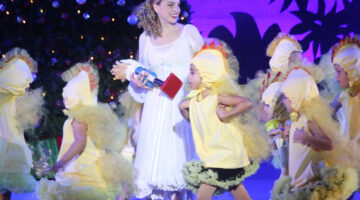The Flying Squalidae
By Mark Howell
Humankind’s flying drones are one thing, but nature’s flying rays are quite another.
Here in the Keys we have primarily yellow rays and to a lesser extent the southern stingray and the spotted eagle ray (also known as the leopard, mussel or cownose ray). You’ll find them mostly on the sand patches around Sand Key and sometimes around the reefs themselves.
Rays are essentially flattened sharks, being Selachians and belonging to the same family of dogfish as squalidae (i.e. inedible) sharks and skates plus some curious links in between.
Rays also breed like sharks except that in the extended mating through birthing season — still happening around about now — they tend to leap energetically above the surface and will even give birth in flight, ejecting a wrapped embryo to unfurl in the air and drop like a kite into the water and swim away.
Rays are also batoids, as are skates, in other words recognizable by their disc shape. The occasional skate may resemble a ray at first glance, but its lobed tail, fleshier than a ray’s, has no sting, and few skates grow to large size.
The lozenge-shaped eagle rays, found in most of the tropical and temperate seas around the world, bear venomous stings above whip-like tails. Our kind in the Keys will grow to a maximum of three feet in width, while elsewhere they can grow to eight feet and weigh up to 800 pounds.
The very biggest batoids can weigh thousands of pounds with awesome, bat-shaped bodies that soar up from the sea to hurtle back and hit the surface with a thunderous splash.
In the course of evolution, the cylindrical body of the shark became squashed, the pectoral fins became greatly enlarged and the basal attachments gradually widened until they united with the sides of the head. That eons-long process is today telescoped into the embryonic development of every ray, with the fetus going through a number of shark-like stages until it completes its gestation as a flat thing.
Our local yellow rays fortunately lack the jackal traits of the bigger sharks. And all rays differ from the shark in that they breathe in reverse, drawing in water through spiracles. The spiracle on the top of the body has a valve and the water is drawn in and then expelled through gill clefts on the creature’s underside. The ray’s destiny is to live on the sea bottom and this method of breathing — on the way out rather than the way in — prevents sand from injuring delicate gill filaments.
Sex among the rays is a phenomenon hard to catch. Courtship is often observable but actual copulation takes place, like the sharks, mostly at night. Once the courting rays’ flying about is done they begin an elaborate behavior involving the males biting the females, then inserting claspers, or hooks at their rear end, into the cloaca of the female located in the female’s pelvic area. Penile intercourse then commences and can last from 10 seconds to two hours. A footnote here from Greg Curry at the Key West Aquarium: “Our beautiful rays are not and never were monogamous.”
The southern stingray is the only venomous ray in the Keys. The Greek name for the electric ray, narke, gives us our word “narcotic.” The Greeks believed the ray to be a “numb-fish” that could bewitch both its prey and the fishermen angling for it. The spellbinding Socrates was nicknamed the Numbfish by his friends. The ancients also believed that the best way to assure an easy delivery for a woman in labor was to put a numbfish in the same room with her.
The electricity in a stingray comes from two groups of specialized cells in which the ordinary electrical-generating ability of any muscle is greatly increased. The electric ray, which stings from the spine, uses it both as a defense and in order to stun its prey.
The Florida Fish and Wildlife Conservation Commission advises that most stingray injuries require immediate medical attention. For more information, contact the National Poison Control Center 1-800-222-1222.
Another FWC Fact: Some seagrass beds, such as those in Florida Bay, are so large they are visible from space.
Quote for the Week:
“The slogan of the University of Texas is ‘What starts here changes the world. Tonight there are almost 8,000 students graduating from UT and it is said that the average American will meet 10,000 people in their lifetime. So if every one of you changed the lives of just 10 people – and each one of those folks changed the lives of another 10 people — just 10 — then in five generations — 125 years — the class of 2014 will have changed the lives of 800 million people. That’s more than twice the population of the United States. Go one more generation and you can change the entire population of the world — 8 billion people.” — From this year’s commencement address to the graduates of the University of Texas by Naval Admiral William H. McRaven, commander of U.S. Special operations.
[livemarket market_name="KONK Life LiveMarket" limit=3 category=“” show_signup=0 show_more=0]




No Comment